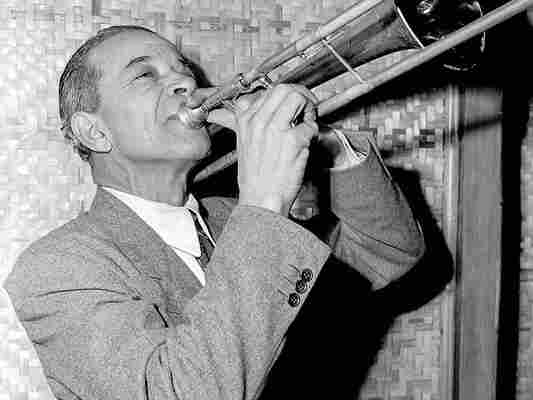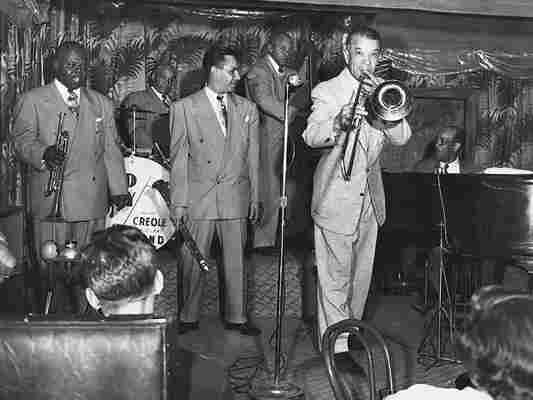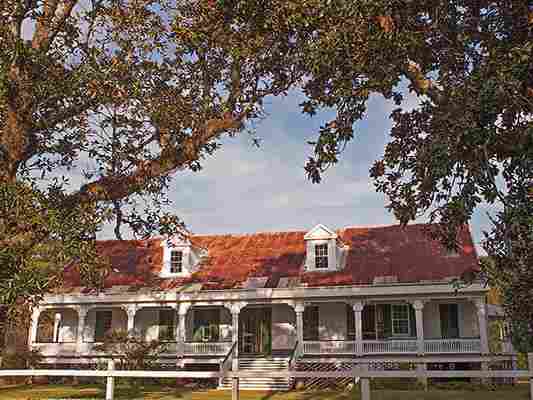
If you were sauntering through the packed-dirt streets of back-of-town New Orleans in the 1910s, anywhere between Storyville and Gert Town, chances are you would have encountered several brass bands blowing a new flavor of music from wagons that promoted upcoming performances. But none of them blew like Kid Ory’s band. Ory wowed onlookers by stretching his trombone slide over the tailgate and blasting competing groups with his signature goodbye tune, “Do What Ory Say,” as the crowd cheered. “Kid Ory’s band would cut all of the bands during his tailgate advertising,” Louis Armstrong marveled in a 1970 interview.
The origins of jazz have always been murky. While the early 1900s bandleader and cornetist Buddy Bolden is often credited with pioneering the “hot” improvisational brass music that became jazz, Ory is largely remembered as a sideman for stars like Louis Armstrong and Jelly Roll Morton. His status as one of the most pivotal bandleaders in jazz, who helped popularize the trombone glissando—a central element of New Orleans jazz—has receded from the popular memory. Yet it was Ory who prepared the ground for the work of nearly all subsequent New Orleans jazz musicians, and who arguably brought jazz into its modern form through his charismatic, innovative playing and his dogged, business-minded bandleading. Remembering Ory as a mere sideman, says John McCusker, author of a 2012 biography of Kid Ory, Creole Trombone , is “like talking about Duke Ellington as a pianist. Ory’s instrument really was the band.”

But jazz’s greatest glissandeur is now being remembered more fully. For the first time, the public can now visit Woodland Plantation in LaPlace, Louisiana, the former 1,882-acre sugar cane operation 29 miles up the Mississippi River from New Orleans where Edward “Kid” Ory was born to Ozeme Ory and Octavie Devezin on Christmas Day 1886. As it happened, Ory’s childhood home was also where the largest uprising of enslaved people in U.S. history originated, the famous revolt of 1811.
Young Ory, who lived in the estate’s former slave quarters with his parents and siblings, had a deep interest in music, and before he picked up an instrument, he and his friends would sing in quartets. “We would stand on a bridge at night and hum different tunes with different harmonies,” Ory recalled. “It was dark and no one could see us, but people could hear us singing and they’d bring us a few ginger cakes and some water....It was good ear training.”

Inspired by the brass bands that performed at settlements up and down the river, Ory and his friends began playing on homemade cigar-box guitars, banjos, violins and a soapbox bass strung with fishing line and metal wire. On occasion, while attending a brass band concert, he would pick up an unused trombone while a group was on break and start working out its mysteries. After he made serious money in 1905, likely from that year’s sugar cane harvest, Ory traveled to Werlein’s for Music in New Orleans and paid $67 for his first trombone—nearly $2,000 in today’s money. It was a shorter model with valves, like those on a trumpet, instead of the longer slide that would soon become synonymous with New Orleans jazz.
With the instrument in hand, he stopped by his sister’s house near Jackson Avenue, which happened to be near a popular musicians’ hangout. Buddy Bolden walked by and heard Ory play. “I was running over the horn...and he stopped and rapped on the door,” Ory recalled in a 1957 interview. Bolden offered him a job on the spot.
Though tempted, Ory couldn’t move to New Orleans; he’d promised his parents before they died that he would stay in LaPlace to take care of his younger sisters. Still, he and his bandmates—by 1911 they were known simply as Kid Ory’s band—began making regular trips to the Crescent City. They had befriended—and learned from—Bolden’s group, whose loose, improvisational style was described as “hot,” as opposed to other brass bands that played to sheet music, including Bolden’s rival John Robichaux.
Ory saw how Bolden had adapted his style of playing from Holy Roller churches, where attendees danced, clapped and moved however the spirit directed them. But to Ory, Bolden played too loud and brash, while Robichaux was too formal. “Bolden was very rough,” said Ory. “You have to give him credit for starting the ball rolling....But he really wasn’t a musician....He was a gifted player with effect but no tone.” So Ory went about creating music that balanced Bolden’s brashness with Robichaux’s professionalism. “[Ory] realized that the way to get the good jobs and get the money—read: get the jobs with the white folks—was to show up, look good, be on time, do all the stuff that John Robichaux did to lock up all that white audience, but play the hot stuff,” says McCusker. Ory would show other musicians in New Orleans how to make a living playing hot music.
When Ory permanently moved his six-piece band to New Orleans, in 1910, he had a new weapon, which became a defining part of his sound: a slide trombone. As you can hear on the 1922 hit “Ory’s Creole Trombone” and innumerable other songs throughout his catalog, the slide enabled him to play glissando and “smear” between notes, which gave his music the boozy sound still associated with New Orleans jazz. Ory was not the first to play a glissando on a trombone, but he was surely one of the most dazzling—and influential.
In 1913, a teenage Armstrong began showing up at Ory’s performances, much as Ory had followed Bolden’s shows eight years earlier, and earned a spot in Ory’s band playing cornet in 1918. But the prohibition of alcohol in Louisiana in 1919, preceded by enforcement of the Wartime Prohibition Act in 1918 and the closing of the Storyville red-light district in 1917, changed the landscape for jazz musicians in New Orleans.
Moving to Los Angeles, where the police seemed less determined to crack down on nightclubs, Ory made history. In 1922, he recorded “Ory’s Creole Trombone” with a new band he’d assembled of fellow displaced New Orleanians. It was the first jazz recording made by black musicians from New Orleans, and it’s an ensemble piece from beginning to end, a burst of polyphony rather than a band supporting a soloist, with Ory’s glissando touches delivering the hook. The tune “offers a rare glimpse into the origins of New Orleans jazz and a remarkable insight to this music’s durability and universal appeal,” David Sager, a musician and jazz historian, said in 2005 when the Library of Congress selected the song for the National Recording Registry, which recognizes exemplars of the nation’s musical heritage.
The song was among half a dozen Ory recordings on three 78 rpms released at once. The entire first pressing of 5,000 records sold out and gave Ory a new audience. Today, an original copy of “Ory’s Creole Trombone” fetches $1,000. The tune and its style of instrumentation inspired groups across the country—and ushered Ory and his signature sound into the Hollywood party circuit while also furnishing gigs down the coast in San Diego and Tijuana.
Following invitations from Armstrong, Morton and Joseph “King” Oliver, in 1925 Ory moved to Chicago, where jazz had recently taken off. Ory recorded sides with Louis Armstrong and His Hot Five and gigged across Chicago for a couple of years, including at mob haunts like the Plantation, where he rubbed shoulders with Al Capone. But recording opportunities slowed in the late 1920s, and the trend toward big-band swing arrangements didn’t favor the music Ory had spent the previous decade and a half playing; he returned to Los Angeles just before the stock market crash of 1929. Paying gigs were scarce during the Great Depression, and in 1933 one of the most important American musicians of the early 20th century put down his trombone and picked up a mop, working as a janitor for the Sante Fe Railway.
In the 1940s, jazz fans, turned off by the less danceable bebop style gaining popularity, brought New Orleans jazz back into vogue. Crucially, in 1942, Ory received $8,000 in back royalties for “Muskrat Ramble”—a tune he’d written and recorded with Louis Armstrong and His Hot Five in 1926. (Ory’s friend and fellow jazzman Barney Bigard, who had experience dealing with rights and royalties, helped him track down the publisher.) The windfall helped ease him back into the Los Angeles music scene.
Ory’s new sextet, based on his classic-era bands, dazzled critics and fans, including Orson Welles, who hired Ory to lead the band on his CBS radio show, “The Orson Welles Almanac,” in 1944. Music writers rhapsodized about Ory’s comeback. “The most important event of 1945 in jazz—speaking of public rather than recorded performance—is the extended run of Kid Ory’s Band in Hollywood,” Rudi Blesh wrote in The Jazz Record in October 1945. “Ory is the Ory of old—he is an artist, the greatest hot trombone of all time.”
Ory continued to perform in Los Angeles clubs until retiring in 1966. He visited New Orleans one last time, in 1971, to perform at the second annual New Orleans Jazz & Heritage Festival, which now attracts half a million people to the city each spring. He died of pneumonia in 1973 at age 86 in Honolulu.
More than a century after his birth, the world Ory grew up in isn’t hard to spot if you know where to look. A neighborhood of modest wood-frame and mobile homes called Woodland Quarters sits on the site of the former slave dwellings where Ory lived as a boy in Louisiana.
Across U.S. Highway 61, green stalks of ripe sugar cane tower six feet high in fields that had once been part of the plantation. The derelict buildings around the corner from Woodland on LaPlace’s Main Street are what’s left of the overseer’s house and the warehouse for the plantation store, where Ory once ordered a banjo. And on the wall of a barn behind the house, a stark reminder of the world Ory escaped remains crudely painted on the wall: Notice. No loafers allowed in here .
